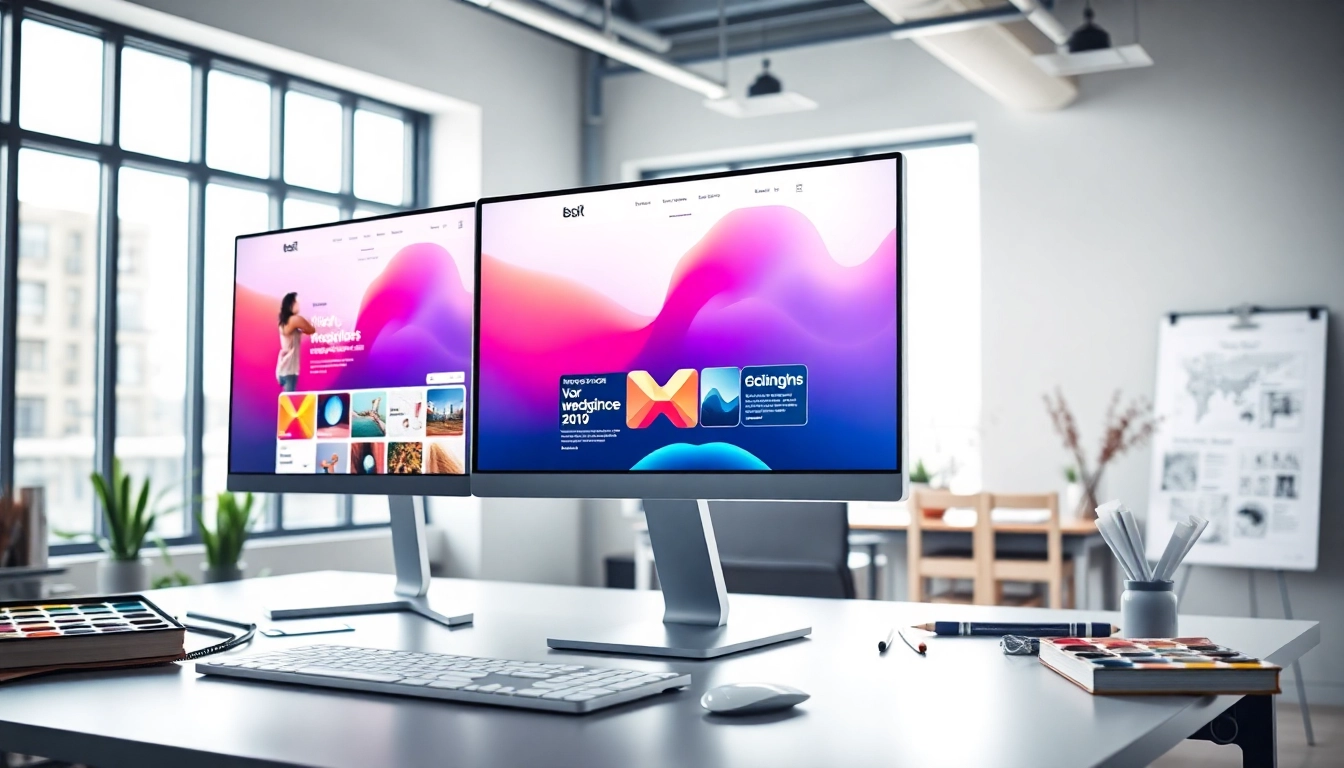Crafting Your Visually Stunning Website Design for Optimal Engagement and Functionality
Understanding the Basics of Website Design
What is Website Design?
Website design is the process of creating the visual and functional aspects of a website. It encompasses several disciplines and skills that are involved in the production and maintenance of websites. This includes web graphic design, user interface design, authoring code (both standardized and proprietary), and search engine optimization (SEO). Effective website design aims to enhance user experience by creating a website that is visually appealing, easy to navigate, and accessible to all users.
A well-designed website can help establish your brand’s presence online and engage visitors. The website serves as a digital storefront, a portfolio, an information hub, or even an online community. Therefore, it is imperative to ensure that the design aligns with the goals of the business and the needs of the target audience. In today’s competitive landscape, investing in quality website design is a necessity rather than a luxury.
Key Elements of Effective Website Design
An effective website must leverage several fundamental elements to achieve a cohesive design. These include:
- Visual Hierarchy: Utilize size, color, and layout to establish a clear connection among elements and guide the user’s eye to priority components.
- Typography: Selecting the right font can enhance readability and evoke the desired emotional response from site visitors. Consistency in font usage establishes brand identity.
- Color Scheme: A carefully curated color palette is crucial for creating a brand identity, conveying emotions, and influencing user behavior.
- Imagery: High-quality images can significantly impact user engagement. Images should be relevant, optimized, and visually appealing.
- Navigation: An intuitive navigation structure enhances user experience and engagement. It allows users to find information effortlessly, promoting longer visits.
- Content: Content should be engaging, relevant, and informative to keep visitors interested and encourage further interaction.
Common Website Design Mistakes to Avoid
Even seasoned designers can overlook essential aspects leading to common pitfalls. Here are frequent mistakes to avoid:
- Poor Mobile Optimization: With a significant portion of users accessing the web via mobile devices, a site not optimized for mobile can lead to loss of visitors.
- Slow Loading Times: Speed is crucial; users will abandon sites that take too long to load. Optimizing images and CSS can help speed up load times.
- Overcomplicated Layouts: A cluttered website can confuse users. Adhering to a minimalist design can enhance user experience.
- Ignoring SEO Practices: Failing to incorporate SEO effectively can make a site invisible to search engines, impacting its reach.
- Inconsistent Branding: Branding elements such as logo, colors, and fonts must remain consistent across all pages for coherence.
Choosing the Right Website Design Tools
Top Website Design Software Overview
When creating a website, selecting the appropriate design tools can significantly streamline the design process. Here’s a look at some of the most commonly used software options:
- Adobe XD: A powerful tool for user interface design and prototyping, Adobe XD allows designers to create interactive prototypes quickly.
- Sketch: Ideal for web and mobile interface design, Sketch offers an intuitive interface and a wide range of plugins that enhance functionality.
- Figma: Figma is a web-based interface design tool that supports real-time collaboration, making it an excellent choice for teams.
- Canva: A user-friendly platform, Canva includes a variety of templates and design elements, making it accessible to those with limited design experience.
- WordPress: A versatile content management system that allows for extensive customization through themes and plugins.
Utilizing Templates for Efficient Creation
Using templates can greatly reduce the time and effort required to develop a website. Here are some benefits and considerations:
- Time-Efficiency: Templates provide pre-designed layouts, enabling quicker project completion without sacrificing quality.
- Consistent Quality: Well-designed templates follow best practices, ensuring functional and aesthetically pleasing designs.
- Ease of Customization: Many templates offer flexibility to accommodate branding and design preferences, making it easy to create a unique look.
Exploring Visual Design Elements
Visual design is integral to capturing users’ attention and enhancing user engagement. Here are some areas to focus on:
- Graphic Design: Incorporating graphics such as icons, infographics, and illustrations can communicate complex information effectively.
- Animation: Subtle animations can enhance user interaction, guiding attention and providing feedback during user actions.
- White Space: Proper use of white space prevents overcrowding, improving readability and creating a more inviting layout.
Best Practices for Website Design
Mobile Responsiveness in Website Design
With increasing mobile device usage, ensuring that your website design is mobile-responsive is critical. Here are strategies to create a responsive web experience:
- Fluid Grids: Use proportional sizing for layout elements to adjust seamlessly to different screen sizes.
- Responsive Media: Ensure images and video automatically adjust to fit the screen without losing quality or getting distorted.
- Media Queries: Utilize CSS media queries to apply different style rules for various devices, enhancing compatibility.
Creating User-Centered Designs
User-centered design focuses on optimizing the user’s experience. Consider these tactics:
- User Research: Gather insights about user needs and behaviors through surveys, interviews, and usability studies.
- Personas: Develop user personas that represent your target audience, which helps guide design decisions.
- User Testing: Conduct regular testing with actual users to identify pain points and areas for improvement in usability.
SEO Considerations for Website Design
Integrating SEO best practices into your website design is essential for maximizing visibility. Here’s what to keep in mind:
- URL Structure: Create clean, descriptive URLs that indicate the page content for better indexing by search engines.
- Image Optimization: Use descriptive file names and alt attributes for images to improve SEO and accessibility.
- Fast Loading Times: Optimize scripts and images to ensure quick loading speeds, as search engines favor fast websites.
Challenges in Website Design and Solutions
Addressing User Accessibility Issues
Web accessibility ensures that all users, including those with disabilities, can navigate and interact with websites effectively. Here are ways to enhance accessibility:
- Alternative Text: Provide alt text for images, enabling screen readers to describe content for visually impaired users.
- Keyboard Navigation: Ensure that all interactive elements are accessible via keyboard controls.
- Color Contrast: Maintain high contrast between text and backgrounds to improve readability for users with visual impairments.
Tackling Loading Speed Problems
Slow-loading websites can deter users and harm search rankings. Monitoring and optimizing for speed is essential. Key actions include:
- Image Compression: Use tools to reduce image file sizes without sacrificing quality.
- Reduce Redirects: Minimize unnecessary redirects to decrease load times.
- Leverage Browser Caching: Set up caching rules to allow browsers to store static files, improving load times for returning visitors.
Balancing Aesthetics with Functionality
While aesthetics are vital for user engagement, functionality should never be compromised. Striking a balance is crucial. Here are suggestions:
- Fluid Layouts: Opt for layouts that adapt visually while maintaining functionality across devices.
- Test and Iterate: Regularly evaluate both aesthetic and functional performance, gathering user feedback for continuous adjustments.
- Prioritize Key Actions: Visual elements should enhance and not detract from significant actions like calls-to-action (CTAs).
Future Trends in Website Design
The Role of AI in Website Design
Artificial Intelligence (AI) is rapidly influencing the landscape of website design. Here are emerging applications:
- Automated Design Suggestions: AI tools can analyze user behavior and suggest design improvements in real-time.
- Personalization: AI algorithms can deliver tailored content to users based on their past behaviors, enhancing engagement.
- Chatbots: Integrating AI-powered chatbots improves customer service capabilities on websites, providing instant assistance.
Minimalism vs. Maximalism in Web Aesthetics
Design philosophies are shifting as trends emerge. Understanding the balance between minimalism and maximalism can inform unique design strategies:
- Minimalism: Emphasizing simplicity with less clutter, this design style promotes focus and ease of navigation.
- Maximalism: Using vibrant colors and a mix of elements to create energy and uniqueness, maximalism can help brands stand out.
- Choosing a Style: The choice between these approaches should align with brand identity and target audience preferences.
Emerging Technologies Shaping Website Design
Technological advancements continuously reshape how websites are designed. Key trends to watch include:
- Voice Search Optimization: As voice search technology becomes prevalent, optimizing for voice queries will be crucial.
- Augmented Reality (AR): AR can offer immersive web experiences, engaging users in innovative ways.
- Progressive Web Apps (PWAs): PWAs combine the best of web and mobile apps, providing a fast, reliable experience for users.








Post Comment